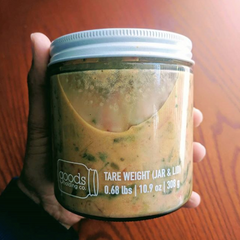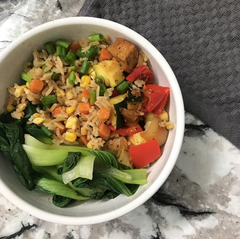While plastic gets a lot of attention for seemingly being Enemy #1 of the low waste community, it’s not the only waste contributor on our hit list. Food, once a simple, natural concept, biodegradable, and part of the circle of life on which we depend, is not so innocent after all.
One-third of the food produced worldwide for human consumption is wasted each year, according to the Food and Agriculture Organization of the United Nations. That’s 1.3 billion tons of food, enough to feed the 815 million hungry people who live on this planet four times over, and equating to $2.6 trillion annually (Reset.org). And while we think these sad facts are sufficiently disturbing enough, it’s important to note that this is also a critical area of opportunity for mitigating climate change. If food waste were a country, it would be the third-largest greenhouse gas emitting country in the world, right behind China and the U.S. (FAO). Food produces methane while it’s decomposing in landfills, which is 28 times more potent than carbon (EPA).
Now, to be fair, only 22% of this wastage occurs at the consumer level, the rest resulting from the agricultural production, postharvest handling & storage, processing, and distribution phases of our food’s life cycle. However, the consumption phase, which refers to us throwing food away in the trash, is responsible for 37% of the carbon footprint (FAO). That’s sobering, but also motivating because it means we can do something about it!
Read on for seven ways you can minimize your food waste starting today!
Keep Your Fridge and Pantry Uncluttered
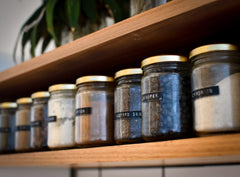
A big part of making sure perfectly good food doesn’t slip through the cracks is knowing what you already have. How many of us have purchased an item only to realize we already had some in the back of the cabinet? *All hands raised*
Have a little time this weekend? Maybe it’s time to do a little organizing in your kitchen. Make sure you can easily see all the items in your refrigerator, freezer, and cabinets. Dedicate places for certain items (and fill in the other members of your household) so you always know where to look for them. Donate any unopened goods you don’t know what to do with to your local food bank. Ask friends and family if they’re interested in any items you’ve opened and don’t expect to finish.
Dispose of items that are clearly past their prime (composting and recycling where possible, of course), but keep in mind that expiration dates often don’t accurately depict when an item is actually past its prime. Use your senses to tell if something looks, smells, feels, or tastes off before you toss it.
Plan Ahead

Everybody has a different strategy for grocery shopping. Maybe you’re the kind of person who gets the same exact things every time you go. Maybe you wing it and get what you’re in the mood for or what’s on sale and figure out how to throw it together later. If it’s not your style already, planning ahead and writing up a list beforehand is a great way to make sure you cut down on waste and get the most bang for your buck.
Think back on the last week. How many meals did you (actually) make at home? Map out what you and your household will reasonably eat between grocery trips. And don’t forget to account for that night you’re inevitably going to be too lazy/busy to cook and end up resorting to leftovers, takeout, or ice cream for dinner. Decide your menu for the week based on ingredients you already have. Note the specific amounts you need of each ingredient to make sure you don’t buy more than what you need. And keep in mind what’s in season as inspiration and to increase the chances that your meals are cheaper, locally sourced, and higher in nutritional value.
Store Properly
We love this post by Zero Waste Chef that lays out how to store pretty much every fruit and vegetable and identifies which produce to keep separate from others to avoid ethylene prematurely spoiling your precious bounty. Here are some of our favorite tips:
- Some stemmed veggies and herbs can be stored upright in a jar of water like a vase of flowers! Change the water out every few days.
- At room temperature: asparagus, basil, celery
- In the refrigerator: carrots, green onions, cilantro
- Cloth bags or napkins are great for keeping all kinds of veggies crisp for longer. Mushrooms, herbs (not including basil), carrots, brussel sprouts, broccoli, bok choy all do well in a dry cloth. Keep leafy greens and other moisture-loving veggies in a damp cloth bag. These Vegetable Crisper Bags are perfect for storing veggies either wet or dry!
- Use an Onion Bag to keep onions, garlic, and shallots stored in a cool, dry place outside of your fridge. This will protect them from light exposure while allowing the onions to breathe, preventing decay. Plus, this onion bag stands upright to keep your cabinets clutter-free!
- Potato Bags are also great for storing potatoes in a cool, dark place. Just make sure to keep them separate from the onions!
- Use Food Huggers to keep leftover halves of fruits and veggies fresh for longer! This works great for citrus fruits, onions, cucumbers, tomatoes, and apples. Want to keep leftover avocado halves from going bad overnight? Use an Avocado Hugger!
- Keep ethylene producers like apples, avocados, bananas, cantaloupe, nectarines, peaches, plums, pears, and tomatoes away from other produce to minimize premature spoilage.
- Store produce that needs to be used sooner than later in one section so you remember to reach for it before it goes bad.
Plan Meals Strategically
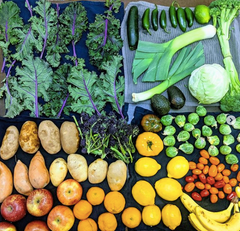
Use ingredients with shorter shelf lives first. Some produce like cabbage, celery, potatoes, beets, leeks, and onions can last over a week if stored properly. Make meals with other produce first to make sure those don’t go bad in the meantime.
What’s your relationship with leftovers like? Do you love making big batches of food so you don’t have to cook again the next day? Or do you hate eating the same thing multiple days in a row? Or do leftovers basically not exist in your household because your family scarfs up everything in sight? Whatever your preferences are, adjust the portions you’re cooking accordingly. Many recipes are easy to halve or double. Don’t forget you can always freeze leftovers of many meals for later (as long as you won’t forget about them)!
Preserve
Don't think you'll have time to use something before it goes bag? Preserve it for later! Lots of produce, as well as bread, cheese, and leftovers are all great to freeze if you don’t think you’ll use them in the next day or two. Use glass or stainless steel containers or reusable silicone bags to replace disposable plastic freezer bags! Or learn how to ferment or can foods to use later.
Scrounge
Still have a little bit of this and that in your fridge, but don’t know what to make of it? Throw veggies in a stir fry, frittata, soup, pasta, quesadilla, risotto, tacos, or on the side of some baked potatoes. Keep extra of the key ingredient on stock for whatever your backup meal of choice ends up being -- veggie stock for soup or rice for stir-fries. For fruit, toss together a fruit salad, make a compote to go with pancakes, whip up a smoothie, or use as a topping for oatmeal. Try to make one scrounge meal before your next grocery trip to use up some of those extra ingredients.
Make the Most of Scraps
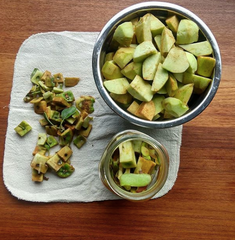
A lot of produce can be regrown in your home without having to buy seeds and without a garden! You can use the stumps, seeds, or sprouted scraps of many fruits and vegetables to grow a new plant from scratch.
- Place leftover green onion, leek, and chive roots (the bottom white part) in a jar of water and watch them resprout. Change the water every few days and you can cut and regrow this plant over and over! You can also do the same with garlic, onions, and other members of the allium family, which will grow sprouts that you can eat like green onions. Otherwise you can plant them to grow new bulbs.
- Avocados, herbs, bok choy, cabbage, root veggies, celery, and lettuce can be grown in a bowl of water and then planted in a pot or in the ground after they develop roots.
- Keep seeds from peppers, gourds, tomatoes, or other fruits to replant if you have space for a pot or if you have a yard or garden.
Check out this guide from Rural Sprout for more info on how to regrow each!
Scraps you’re not able to regrow can also serve a purpose! Freeze scraps from onions, garlic, carrots, celery, bell pepper, leeks, green onions, mushrooms, and herbs for a homemade veggie stock. (Skip cruciferous or starchy vegetables like broccoli, brussel sprouts, or potato scraps.) Make bread crumbs or croutons out of stale bread. Soak citrus rinds or herbs in vinegar for a DIY all-purpose cleaner base. Use too far gone apples to make your own applesauce or apple cider vinegar! Or make pesto with leftover greens like basil, kale, spinach, even carrot tops!
Compost
For whatever food scraps you’re not able to salvage, composting is the best way to minimize the waste going to landfills and the resulting methane emissions. Compost also makes great fertilizer (thank you, circle of life!), especially as a safer and more affordable alternative to chemical fertilizers that you can either use in your garden or your municipality can collect to share with the agriculture industry. (EPA)
If your local municipality doesn’t collect compost curbside, it’s seriously worth considering how you can compost in your own home. There are many ways to do this, even if you live in an apartment. Check out our blog post on How to Compost in an Apartment or learn more about how to compost here. If you’re not ready to take it on yourself, you can find someone near you to donate your kitchen scraps to with the app Share Waste! Collect your scraps in a compost canister or in a bag in your freezer between trips to donate.
Bonus: One other benefit of reducing our food waste is that it saves you money! That’s money you don’t waste buying food you won’t eat, and you might even be able to keep a couple items off your list if you’re making your own at home!
Have any other tips for preventing food waste? Share in the comments below!



